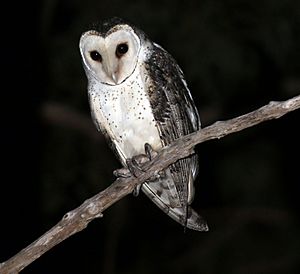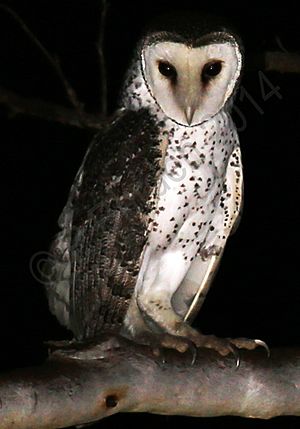Northern masked owl facts for kids
Quick facts for kids Northern masked owl |
|
|---|---|
 |
|
| At Groote Eylandt, off the coast of Australia's Northern Territory | |
| Conservation status | |
| Scientific classification |
|
| Kingdom: | Animalia |
| Phylum: | Chordata |
| Class: | Aves |
| Order: | Strigiformes |
| Family: | Tytonidae |
| Genus: | Tyto |
| Species: | |
| Subspecies: |
T. n. kimberli
|
| Trinomial name | |
| Tyto novaehollandiae kimberli (Mathews, 1912)
|
|
 |
|
| Tyto novaehollandiae kimberli range | |
| Synonyms | |
|
|
The northern masked owl (Tyto novaehollandiae kimberli) is a large forest owl. It belongs to the family Tytonidae, also known as barn owls. This owl is a type of Australian masked owl. It was first described in 1912 by an Australian bird expert named Gregory Macalister Mathews.
You can find it in forests and woodlands across northern Australia. This includes the northern Kimberley area. It also lives in the northern Northern Territory and the western Gulf of Carpentaria. The Australian masked owl is the largest barn owl species. However, the northern masked owl is one of its smallest types.
Contents
About the Northern Masked Owl
The northern masked owl is a subspecies of the Australian masked owl (Tyto novaehollandiae). This large owl looks a lot like the common barn owl. Australian masked owls live in non-dry areas of Australia. They are also found in southern Papua New Guinea. Some islands north of Papua New Guinea and in Indonesia are home to them too.
Scientists have identified eight types of Australian masked owls. But there has been some confusion about them. Some types once thought to be separate species are now seen as subspecies. For example, T. manusi and T. sororcula are now considered subspecies.
Different Types of Masked Owls
In 1912, Gregory Mathews named eight subspecies of masked owl in Australia. These were based on where they lived and how they looked. Later, two more types were described.
Today, only four of these subspecies are officially recognized in Australia:
- T. n. novaehollandiae (found in eastern, southern, and southwest Australia)
- T. n. castanops (found in Tasmania)
- T. n. melvillensis (found on the Tiwi Islands)
- T. n. kimberli (the northern masked owl, found in northern Australia)
There are also four other types found outside Australia. These include owls from southern Papua New Guinea and islands in Indonesia.
Some experts believe the owls from Cape York Peninsula are a separate type. Others group them with the northern masked owl. The relationship between these different types is still being studied.
What Does the Northern Masked Owl Look Like?
Gregory Mathews said the northern masked owl is smaller and paler. It is lighter in color than the main type of Australian masked owl. Later studies confirmed it is one of the smallest Australian masked owls. Only the Tiwi masked owl is smaller.
Female northern masked owls weigh about 700 g (25 oz). Males are lighter, at about 450 g (16 oz). This is much lighter than the Tasmanian masked owl. Tasmanian females can weigh up to 1,260 g (44 oz). Males can weigh up to 800 g (28 oz).
Where Do Northern Masked Owls Live?
The northern masked owl is not common. It is spread out across large parts of northern Australia. Its main homes are the north-west Kimberley region. It also lives in the northern Northern Territory and Groote Eylandt.
Many owls live in the north-west Kimberley and Kakadu National Park. They are also found in Garig Gunak Barlu National Park and on Groote Eylandt. Some live on islands like Augustus and Koolan Islands. They are also on Akwamburkba (Winchelsea Island) and North Goulburn Islands.
In recent years, owls have been seen on Groote Eylandt and in north-eastern Arnhemland. They were also spotted in Kakadu National Park and the Mitchell Plateau.
Northern Masked Owl Habitat
Northern masked owls mostly hunt in open eucalypt forests. These forests have open areas below the trees. They rest in dense monsoon forests or tree hollows.
They also hunt in more open places. Owls have been seen in Melaleuca forests and rainforests. They can also be found in grasslands and coastal dunes. In the Northern Territory, they often live in tall open forests. These include areas with Darwin stringybark (Eucalyptus tetrodonta) trees. On Groote Eylandt, they hunt in tall open forests and woodlands.
Northern Masked Owl Behavior
Home Range
The southern Australian masked owl usually has a home range of 5–10 square kilometers. Scientists think the northern masked owl might cover a similar area. Many northern masked owls have been found on Groote Eylandt. Their home range there is estimated to be 4–5 square kilometers. This is based on studies of large forest areas.
Roost and Nest Sites
Northern masked owls rest during the day in tree hollows. These hollows are usually in the trunks of large, living or dead trees. They also roost on branches in thick plants. This includes monsoon vine forests and plants along rivers. Recently, roost sites in the Kimberley were found near tall Melaleuca forests. These were next to sandstone cliffs and open woodlands.
Foraging and Diet
We don't know much about what northern masked owls eat. But it's probably similar to southern masked owls. Southern owls mostly eat small to medium-sized mammals. They also eat some tree-dwelling mammals, insects, and birds.
Two northern masked owls from the Kimberley had small birds and marsupials in their stomachs. These included savanna gliders. Northern masked owls have also been seen eating brush-tailed rabbit-rats on Groote Eylandt.
Vocalisation
Northern masked owls make several different calls. The most common call is a loud, long, rasping screech. They make this call while sitting or flying. It might be used to defend their territory or to call to other owls.
They also make a "chatter" call. This sounds like a loud cackle or continuous chatter. This call is likely made by males during courtship flights. They circle over their breeding area while making this sound. Other social calls are not well known. But they are probably similar to other masked owls. These include high-pitched trills and hissing sounds. They also make low cooing sounds during mating.
Reproduction and Life Cycle
We have limited information about how northern masked owls reproduce. They lay 2–4 eggs in a large tree hollow. Clutches of eggs have been found in the Northern Territory in May, August, and September.
Conservation Status and Threats
Status of the Northern Masked Owl
The IUCN (International Union for Conservation of Nature) says the Australian masked owl is of 'least concern'. But they haven't given a specific status for the subspecies. The northern masked owl is listed as a vulnerable species. This is under Australia's EPBC Act 1999. It is also listed as vulnerable in Queensland and the Northern Territory.
The Action Plan for Australian Birds 2020 also called it vulnerable. Even though many owls were found on Groote Eylandt, their prey is declining on the mainland. This might cause their numbers to drop. It's hard to know exactly how many there are because they are rarely seen on the mainland.
Owl Population Status
The northern masked owl seems uncommon in most places it lives. A recent estimate suggests there are 2,000 to 5,000 adult owls. This number does not include those in Queensland.
Some places still have many northern masked owls. These include Garig Gunak Barlu National Park and the north-west Kimberley. The Anindilyakwa Indigenous Protected Area (Groote Eylandt) is also important. These areas might be safe places for the owls. They may have been less affected by fires, farming, and feral animals.
Threats to the Northern Masked Owl
Humans cause the main threats to northern masked owl populations. These include clearing land and changes in fire regimes. Also, too many non-native animals like cattle and feral animals hurt their habitat. Pollution leading to global heating is also a threat.
The biggest threat is thought to be a lack of prey animals. This is linked to more frequent and larger fires. Feral cats also hunt the owls' prey. Grazing by feral animals and weeds make these problems worse. Only Groote Eylandt and the Kimberley still have many prey animals.
The large trees and hollows needed for nesting might be decreasing. This is due to more intense and frequent fires. However, these trees are still common. Owls can move around a lot, so they might be less affected by local fires. Mining activities also cover large areas where the owls live. This includes most of Groote Eylandt.
A study found that the northern masked owl has a medium sensitivity to global heating.
Conservation Areas
The northern masked owl has been seen in several protected areas. These include the Mitchell River National Park (WA). Also, Kakadu National Park (NT) and Garig Gunak Barlu National Park (NT). They are also in Keep River National Park (NT) and Nitmiluk National Park (NT).
Northern masked owls are also found in private conservation areas. These are managed by the Australian Wildlife Conservancy. They live on Groote Eylandt and Akwamburkba (Winchelsea Island). These islands are part of the Anindilyakwa Indigenous Protected Area. The owls also live in many other Indigenous Protected Areas.
- Northern Territory Department of Land Resource Management Threatened Species of the Northern Territory Profiles – Masked Owl – North Australian Mainland Subspecies [1]




